 |
Flying High With Electric Power!
The Ampeer ON-LINE!
Fly the Future - Fly Electric! |
|---|
Site Table of Contents
| President: | Vice-President: | Secretary-Treasurer: |
| Ken Myers | Richard Utkan | Rick Sawicki |
| 1911 Bradshaw Ct. | 240 Cabinet | 5089 Ledgewood Ct. W. |
| Commerce Twp., MI 48390 | Milford, MI 48381 | Commerce Twp., MI 48382 |
| (248) 669-8124 | (248) 685-1705 | (2480 685-7056 |
 | ||
| Board of Directors: | Board of Directors: | Ampeer Editor |
| David Stacer | Arthur Deane | Ken Myers |
| 16575 Brooklane Blvd. | 21690 Bedford Dr. | 1911 Bradshaw Ct. |
| Northville, MI 48168 | Northville, MI 48167 | Commerce Twp., MI 48390 |
| (248) 924-2324 | (248) 348-2058 | (248) 669-8124 |
| The Next Meeting: Date: Wednesday, April 11 Time: 7:30 p.m.
Place: Ken Myers' house | ||
| Advice for Getting Into Flying Radio Controlled (RC) Airplanes Ken Myers shares his experience about what makes a 'good' beginner's plane and some general advice on getting into the hobby. | Upcoming Keith Shaw Birthday Party Electric Fly-in 2018 Event announcement |
| Skymasters' Electric Night Fly and Fly-in Event announcement | Fore and Aft Balance: Initial Safe Center of Gravity (ISCG) Article Updated Ken announces an update to this center of gravity article. |
| The Power of Two Ken discusses his observations about the theory of the power of two. | Upcoming 34th Annual Mid-America Electric Flies 2018 Great Event Announcement |
By Ken Myers Preface Please be aware that this is an opinion piece. MY OPINIONS are based on over 50 years of flying RC planes and well over 40 years as a RC flight instructor. YouTube has a lot of videos covering the topic of RC airplanes. That's good, but... Visiting an RC flying site, where you can actually see RC model airplanes in use, is better. Real life experience is invaluable. While visiting, you will see the area required to fly different types of planes and actually see various types of planes in action, as well as the support equipment being used. Local hobby shops, that have a good selection of RC equipment, usually have a list of known flying sites in the area The Academy of Model Aeronautics has a list of chartered flying sites. A search within 25 miles of my zip code showed 17 clubs in this area of southeastern Michigan. You may, or may not, want to join a club. That's fine. You should still try to visit a club in your area just to see the 'hobby' in action. There are links to the various clubs' Web sites on the AMA search site. Their Web sites usually have maps to their flying sites. Plan your trip on a good flying day. Do not try to visit an RC flying field when its too cold to be comfortable outside or when the wind is standing flags straight out and the traffic signals are swaying a lot. That tip about the 'weather' also holds true when you are learning to fly. While the day may seem very pleasant, temperature-wise, it may not be a good RC 'learning to fly day'. When just learning to fly RC planes, breezes should be at a minimum. It is imperative to be patient and wait for the correct conditions, whether you are teaching yourself or you have located a flight 'instructor/mentor'. YouTube videos show planes flying, but until you actually visit an area where RC planes are being flown, you have no reference as to how much area your choice of an RC training plane actually needs. Words like 'backyard' and 'park' abound in many sources. In reality, those descriptions, are at best, subjective, as to the actual physical size of the area. More importantly, the area to fly in is dependent on the skill of the pilot. As a beginner, your skill level is zero. Flying in a 'park', with others present that are not involved in your activity, presents a clear and present danger to them and it is a liability that you have chosen to introduce in that area. The area required is also dependent on the type of plane you select as your trainer. There are a lot of planes that make excellent trainers that cannot be flown in a 'backyard' or 'park'. You need more room than you think. The area needs to be clear of 'objects' such as trees, poles, fences, goals, backstops etc. If they are present in the area you've chosen to fly in, you WILL hit one of those objects. The YouTube video shows a beginner who chose to fly in a 'park'. It didn't work out well for him. He also made the mistake of not choosing a good trainer plane as his first RC airplane. Don't let this happen to you. Even very experienced RC pilots can misjudge and not choose the correct flying area. I wanted to do a maiden on a new 'park flyer' type plane, but I didn't want to drive out to the RC flying field I use. I did everything wrong. The area, a local park just down the street, was large enough. It was early enough in the spring that there was no one using it. Unfortunately, it is filled with many objects. It flew okay. The wind was quartering from my front right side, so I chose to land at an angle to how I was flying so that I could land into the wind. There were no leaves on the trees yet. I didn't see the 15 foot tall tree behind me and to my right. I flew right into its branches. The plane caught and rested in the branches about eight feet off the ground. A trip home, to get a ladder, was required to retrieve the plane. The point; choose an area that is larger than you 'think' you need and be sure it is free of objects. Choose to orient your flight so that takeoffs and landings are into the wind. This is a 'sad' video. The user was a low time pilot who chose a horrible flying site. If there are poles or trees, you WILL hit them. The pilot lacked both the skill to fly the plane, even though the advertising states in the supplier's video, "THE ALL-PURPOSE AIRPLANE THAT ANYONE CAN FLY", he also lacked sound flying site selection judgement. Don't let this happen to you! When setting up to fly, be sure that the sun is behind you while you are flying in front of yourself. If the sun is not behind you, you WILL fly the plane between you and the sun. It WILL happen. When it does, you WILL be blinded for several seconds. Spotting the plane again and picking up its orientation will be extremely difficult. About 5 seconds of this video shows what happens when a plane flies through the sun. The camera recovers much faster than your vision! Your flying gear should also include a hat with a brim and sun glasses. The brim, if worn to the front of the hat, will help shade your eyes for a better view of the plane and sun glasses will reduce squinting when looking at a bright sky. A bright sky can even happen on a totally cloudy day. Dark, totally cloudy, days are not good days for beginners to fly. No matter what color the training plane is, it tends to 'look' gray against a very gray sky. There is little definition between the plane and its background. Orientation becomes extremely difficult. Even very experienced pilots can 'lose' the plane for an instant with this type of cloud condition, but their experience usually 'saves' them, while a low time pilot can totally 'lose' orientation and crash. The Flite Test video shows two planes flying on a bright, yet totally cloudy day. Selecting a good trainer airplane is extremely difficult. You will hear many, many, many opinions on what makes a good trainer. Your individual financial circumstances, personality and location play an important role in determining what plane will be best for YOU to begin with. No matter what decision, or path, you decide to follow, there are some basic 'rules' for selecting a plane that will work as a good RC trainer. Some, or all, of these suggestions should be taken into consideration when selecting your first aircraft. 1. The fewer the number of functions you control, the easier it is to learn.
2. The plane should be 'relatively' slow. This allows your 'untrained' brain to 'learn' the stick inputs required to 'make' the plane do what you want it to do. A plane can only fly slowly if it has a low wing loading. 3. The plane should be somewhat durable. That doesn't mean that it won't break if an unintentional landing occurs, but that most of it will be flyable again soon after a minor repair. Foam type planes are, for the most part, the easiest to repair and get flying again. 4. The plane should not necessarily be 'beautiful' in your mind. Beautiful planes come later in the learning curve. There should be no fear of messing up your trainer in the back of your mind. If there is, you've chosen the wrong trainer. 5. Electrically powered trainers have almost no learning curve regarding the operation of the power system at the flying field. Turn it on and go flying. Gasoline and glow fuel powered engines do have quite a learning curve themselves. Move onto them later if you are interested in them. 6. The plane's flight characteristics must match the area you intend to fly in. It is not so much a matter of size of the area, but how much room the plane needs to land when flown by a beginner. 7. A larger size plane, with a low wing loading, is better to learn on than a smaller size plane with the same wing loading. The flying area must be suitable for landing the larger size plane. 8. Your progress is totally based on you as an individual. Some folks pick up RC flying more quickly than others. How quickly it is 'learned' depends on often RC flying can be practiced and how frequently the sessions can be connected. The Types Ready to Fly (RTF), everything is in one box that allows you to make one flight and then wait a considerable time for the provided single battery to recharge on the extremely low powered battery charger provided in the box. Bind and Fly (BNF), almost everything is in one box that allows you to make one flight and then wait a considerable time for the provided single battery to recharge. A Spektrum brand transmitter (Tx) is a required purchase to match the Spectrum receiver (Rx) installed in the plane. Tx-R (transmitter ready) planes, sold by Tower Hobbies require a transmitter that can transmit on the SLT protocol; Tactic or the newer Hitec. FTR (Futaba Transmitter Ready) planes, sold by Motion RC, require a Futaba transmitter. Receiver Ready (Rx-R) or (RR+), much of everything is in one box that allows you to make one flight and then wait a considerable time for the provided single battery to recharge. A transmitter (Tx) and receiver (Rx) of the user's choice is required. Ready Built/Plug and Play (PNP) or (RR), much of everything for the airframe is in one box with some onboard equipment installation completed. Some assembly of the airframe is still required by the user. It also requires the battery, battery charger, transmitter and receiver to be purchased separately. Almost Ready to Fly (ARF), contains the pre-finished airframe parts ready for assembly. The user must install the radio system and power system of choice. Kits, assembly from some type of construction material is required. All of the components for the power and radio system must be selected by the builder and installed. Scratch Built, the airplane is built from plans using some type of construction materials. All of the components for the power and radio system must be selected by the builder and installed. Glow powered trainer conversion to electric power, ABSOLUTELY NOT FOR BEGINNERS. Self-designed, scratch built, ABSOLUTELY NOT FOR BEGINNERS. 1. 3-channel electrically powered gliders
2. 3-channel electrically powered glider-type pushers
3. Micro 3-channel Trainers
4. Conventional (tractor type) 3-channel Trainers
5. (Pusher type) 4-channel/function glider-like
6. Conventional (tractor type) 4-channel/function Trainers
There are NO trainer planes that come with everything you actually need; zero, nada, zip!!! Many suppliers 'suggest', as optional items, more batteries, a 'better' battery charger and most importantly of all, a fire resistant container for Lithium Polymer (LiPo) batteries. Those three items are REQUIRED to learn how to fly RC planes and to protect yourself and your property. More than one battery is required, unless you want to wait an hour or more between flights. That is the typical time it takes a depleted LiPo battery to recharge, especially with the provided chargers in RTF and BNF packages. The chargers supplied in RTF and BNF packages are dumb. They provide no information to the user as to the state of charge or milliamp hours (mAh) returned to the battery during a charge. LiPo batteries should never be drained to more than 80% of their stated capacity. The mAh returned to the pack is used to determine how deeply the battery was discharged. The supplied chargers could also be called, "Plug and Pray" chargers. LiPo batteries should always be charged outside your vehicle, or your house, on a noncombustible surface and away from anything combustable. Some of the "Plug and Pray" chargers plug into an accessory socket of a vehicle with a chord that is not long enough to exit the vehicle, so that the LiPo battery cannot be charged outside the vehicle. Other supplied chargers plug into a USB port. That port could be on a device in your house or your vehicle. Some are even supplied with an AC adapter to charge in your house. Both types of supplied chargers are a bad idea just waiting for a LiPo event to happen. LiPo batteries can contain a lot of energy. They are energy dense when fully charged. They should NEVER be stored for long periods of time at the full charged state. Some folks say that stored LiPo batteries, not fully charged, have no risk of causing an event. I personally know two people who will disagree with that statement, as they both had 'stored' LiPo events. Here is a link to some more reported events on RC Groups. I can only recommend one brand of LiPo Sack or Bag, the real LipoSack brand from Mark Wood in California. There are cheap bags. They will actually burn. The video shows many other brands actually have a coating on them that will burn and add fuel to the incident. To learn more about LiPo incident containment, see Part 2 of "Learning About LiPo Batteries". Disclaimer: I do not know Mark Wood. I have never met Mark Wood. I have NO financial interest in LipoSack. I am a paying customer, like anyone else. Please, do yourself a favor and purchase only the REAL LipoSack that meets your needs. It is made here in the USA and it is really cheap insurance. LiPo batteries should not be discharged to lower than 80% of their stated capacity. A flight must be timed to keep this from happening. A timer on a smart phone or inexpensive kitchen timer can be used. Some computer-style radios have built-in timers. I extensively researched 30 RC planes which suggested, in their literature, that they were 'trainer' types. The complete list, and my notes are located here. I was very surprised, after analyzing my data, that four of the five planes I am recommending are from Horizon Hobby. All four have AS3X stabilization and two also have a version of SAFE. Watching about one minute of this Flite Test video gives some important information about using SAFE and weaning off it as soon as possible. Don't confuse SAFE and its variations with AS3X stabilization. I've tried to give a close approximation to the actual amount of money that might be involved in getting into the hobby. I have included an extra battery or batteries, a decent charger for the type of battery and a LiPo sack in the pricing to more closely reflect the actual cost. Shipping and taxes are not included. Specific recommendations, my comments regarding the aircraft and links for purchasing items can be found here. 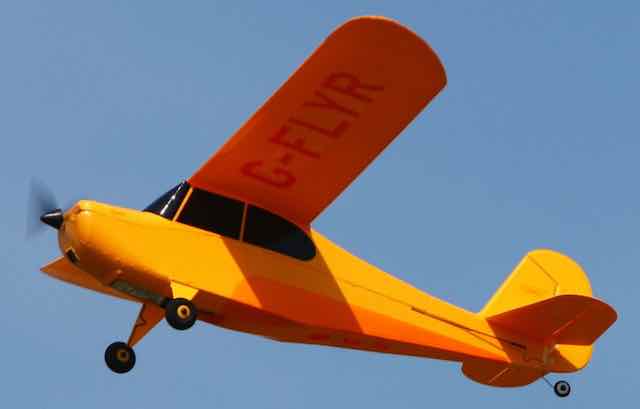
Horizon Hobby Photo hobbyzone Champ RTF ($89.99), wingspan 20.3" - $178.90 The Flite Test video shows how well, and easily this plane flies while the guys are having some fun as well. 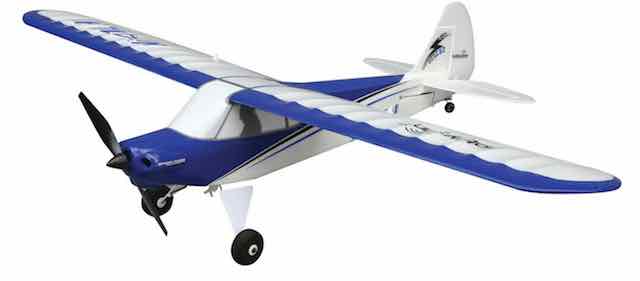
Horizon Hobby Photo hobbyzone Sport Cub S RTF with SAFE ($129.99), wingspan 24.3" - $219.90 The Flite Test video shows three of these planes in action indoors. 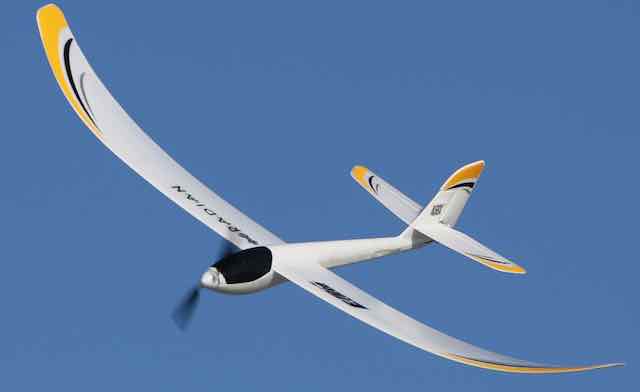
Horizon Hobby Photo E-flite UMX Radian BNF with AS3X ($89.99), wingspan 28.7" - $241.89 - Transmitter is purchased separately but included in the price you see. The Flite Test video shows three of these planes in action. 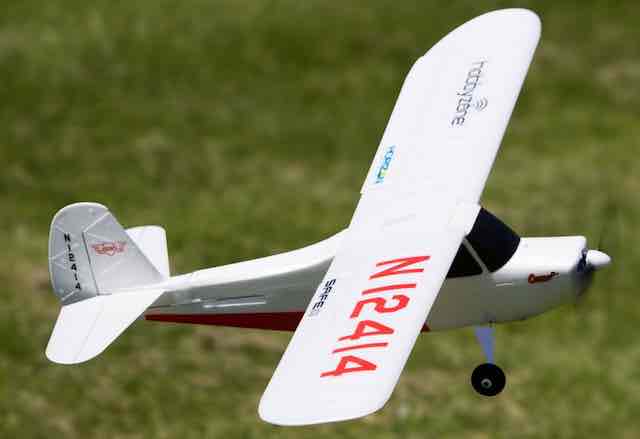
Horizon Hobby Photo hobbyzone Champ S+ RTF ($169.99), wingspan 27.3" - $287.92 The video is from an unbiased 3rd party who shows it actually working as described. 
Flite Test Photo FliteTest FT Explorer wingspan 57" - $254.33 to $291.33 plus adhesives
Building from a kit or scratch building from Flite Test's free plans is an excellent way to enter the hobby. If you think that you can't build your own trainer, watch the build video to see how easy it can be with the help of the folks at Flite Test. Some people find computer RC flight simulators useful in learning hand to eye coordination and enhancing muscle memory. The Phoenix R/C Pro Simulator V5.5 with DX6i Transmitter is $219.99. The transmitter is a generation old, but could be used instead of the DXe mentioned in my component listings. The Great Planes RealFlight RF8 w/InterLink-X Controller is $179.99. The controller can only be used with the simulator. A Detrum 8-Channel R/C Flight Simulator Controller is $29.99. It requires the purchase of the ClearView RC Flight Simulator for $39.99. The Dynam 6CH 6-Channel FMS USB RC Flight Simulator DYU-1002 Mode 2 Left Throttle Packaged with the free FMS RC simulation software can still be found on Amazon for $29.64. Do a search on Amazon for it. More information on RC flight simulators can be found in the RC Groups Simulators forum. Almost all RC Flight Simulators computer programs are for Windows OS systems. I wrote a review of AeroFly RC7 for the Mac. Many areas in the USA have venues that allow indoor flying for certain types of small RC model aircraft. A Google search for indoor RC flying in your area might list some of these venues with dates and times. Unfortunately, indoor RC flying is scheduled at venues when they are not being used for their primary purpose, and that means the hours for RC flying are generally while folks are at school or work. This video is Flite Test's "RC Planes for Beginners: How to Choose" from their Beginner Series. This is Ep. 1 - Oct. 16, 2013 The video is sponsored by Horizon Hobby. The aircraft shown are, or were, available from Horizon Hobby as well as local hobby shops. There are other suppliers of good beginner aircraft. This is Flite Test's "Top 5: Best First RC Planes" - Feb. 13, 2017. It is an update of the original's information. The video covers both 3-channel and 4-channel planes. "1 Tip for New Beginner RC Airplane Pilots" is a thread on RC Groups where folks share tips for beginning RC pilots. EVERYTHING YOU WANTED TO KNOW ABOUT ELECTRIC POWERED FLIGHT" by Ed Anderson, is an online book. "Getting Started in Electric Flight: A Power System Introduction and some BASICS", by Ken Myers, is an article covering the basics of electrically powered flight. Upcoming Keith Shaw Birthday Party Electric Fly-in 2018
The Balsa Butchers are hosting the "Keith Shaw Birthday Party Electric Fly-In", for the 17th year, at their field near Coldwater, MI. The event takes place on Saturday, June 2, 2018. It is a one day event again this year. The event consists of Open Electric Flying with a "Special Guest of Honor Theme", Happy Birthday Keith Shaw. Enjoy a day with the "Pioneering Master of Electric R/C Flight". 8 am - 5 pm, Saturday. New this year, NO LANDING FEE! Donations for field maintenance and lunch appreciated. For additional information contact;
The field will be open for guests to fly on Sunday as well. 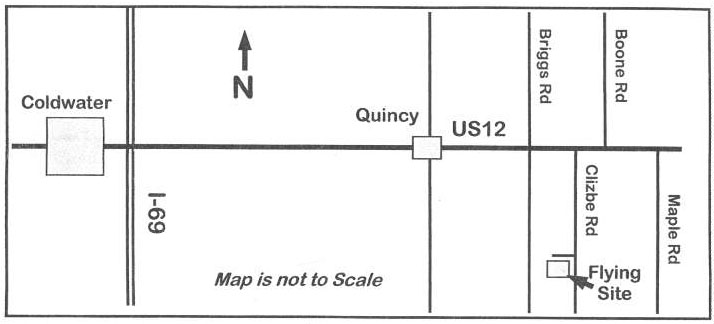 Directions: Quincy is approximately 4.5 miles east of I-69. Clizbe Road is approximately 1.6 miles east of Quincy. The Flying site is approximately 1.5 miles south of US-12 on the west side of Clizbe Road. Skymasters' Electric Night Fly and Fly-in
The Skymasters' Annual Electric Night fly will be held on Saturday, June 9 and the electric fly-in is on Sunday, June 10. More details will follow when they become available. Fore and Aft Balance: Initial Safe Center of Gravity (ISCG) Article Updated The article was updated on January 12, 2018. The updates include; electronic device cross-platform formatting, URL link updates, video link updates, and some corrections and clarifications. The Power of Two
It has been my life experience that when I have two of the same, or very similar things, the first one will last longer than when I have just one of a kind.  The photo shows just a few of the 'twos' I have and use all of the time. So far, all of the 'ones' are working just fine, but who knows what would have happened if I only had one and really needed to use it right then!  My new 'trainer' plane was designed with "The Power of Two" in mind. Based on my experience, the first airframe should lasts a long time (or not). If something does happen to it, so that can't be easily repaired, then the number "two" airframe can be set up quickly. This allows the student pilot to get back into the air in a timely manner. Another "plus" for two airframes is that many of the airframe parts from the original number one airframe, if it should become unrepairable, can be used to create another number "Two" airframe. That cuts down on the total building time for the new number "Two" airframe, as well as the expense. Upcoming 34th Annual Mid-America Electric Flies 2018
The 7 Mile Rd. Flying Site, Salem Twp., MI, is Provided by the:
Contest Directors are:
Flying both days at the Midwest R/C Society Flying Field - 7 Mile Rd., Salem Twp., MI Registration: 9 A.M. both days
Pilot Entry Fee: 18 and over, $15 Sat. - $10, Sunday, (ask about the family rate),
Saturday's Awards
Sunday's Awards
Planes Must Fly To Be Considered for Any Award
Open Flying Possible on Friday
Potluck picnic at the field on Saturday evening. Come and join us for two days of fun and relaxed electric flying. Come, Look, Listen, Learn - Fly Electric - Fly the Future!
Special Events again for this year for NCM (Not Conventional Materials) aircraft. Traditionally, model aircraft airframes have been mostly constructed from balsa wood, plywood, spruce, and fiberglass. For the purposes of this meet, NCM airframes are mostly constructed from not conventional materials i.e.; sheet foam, foam board, cardboard, block foam, foam insulation material, etc. Foam Flurry for NCM aircraft: This is a true event. It is based upon the all up/last down event of early electric meets. Any NCM aircraft may be used (no ARF types). Power systems are limited to a maximum of 3S (no paralleling) LiPo batteries or 4S maximum, no paralleling, for A123 packs. All planes qualifying for this event will launch at the same time, and the last one to land will be declared the winner. Most Unique NCM Aircraft Award: An award will be given on Sunday to an aircraft in the NCM category that is judged as 'most unique' by the Mid-Am panel of judges. The field entrance is on the north side of Seven Mile Road about 1.6 Miles west of Currie Rd.
Because of their convenient location and the easy drive to the flying field, the Comfort Suites and Holiday Inn Express in Wixom, MI have been added to the hotels' listing. They are only 10 miles northeast of the field and located near I-96 and Wixom Road. See the map-hotel .pdf for more details. The Midwest Priceless Sale at the flying field. No prices on any items. Make a reasonable offer and its yours. Money goes directly to the Midwest RC Society. No charge for space. The $5 requested donation for non-participant entry parking would be appreciated. To Reach Ken Myers, you can land mail to the address at the top of the page. My E-mail address is: KMyersEFO@theampeer.org |